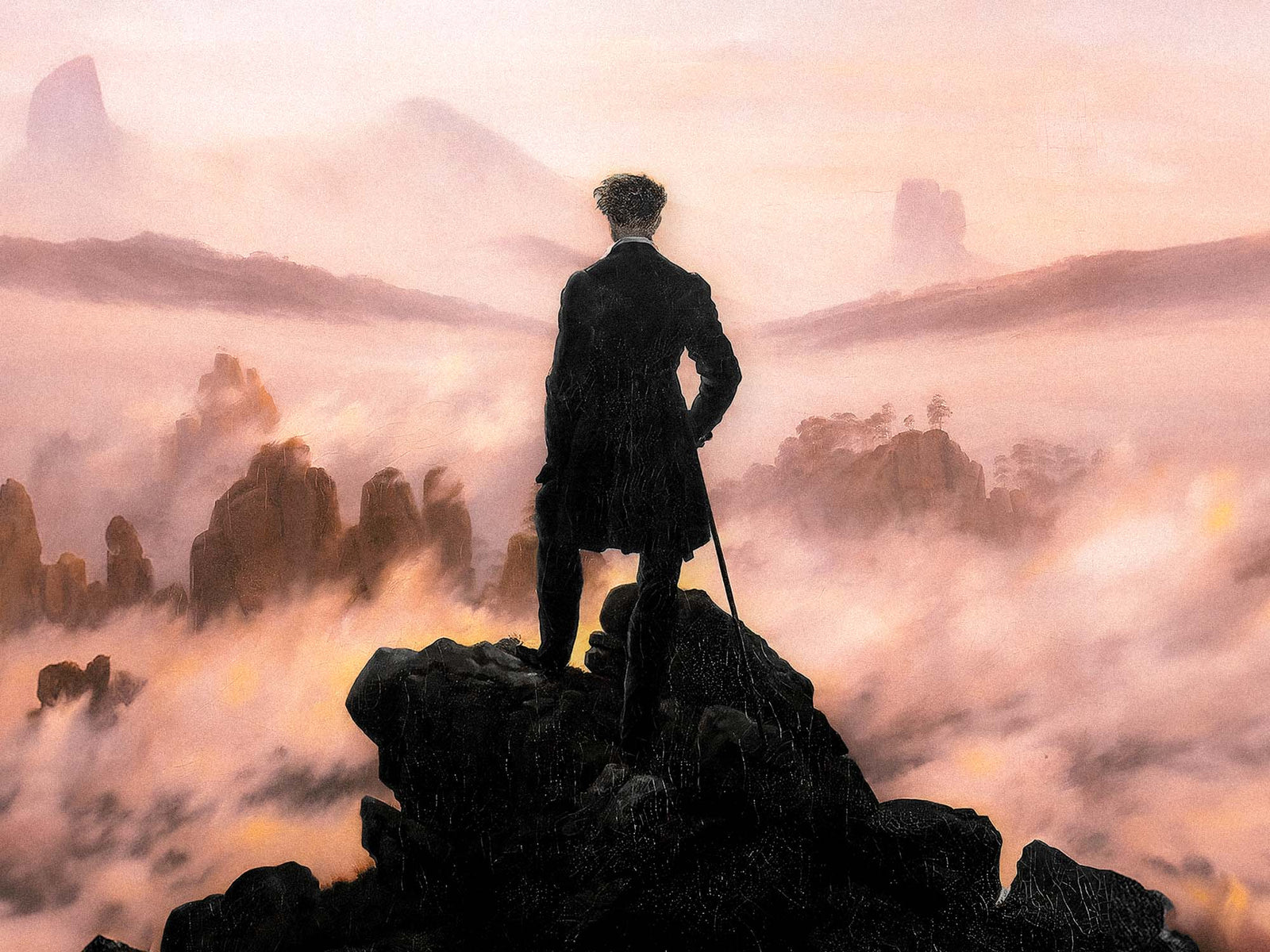Deep Dive: The Wanderer Above a Sea of Fog
Daniel Speight
·
21 October 2024
·
4 min read

Caspar David Friedrich’s The Wanderer Above a Sea of Fog, painted in 1818, stands as one of the most iconic works of the German Romantic movement. At first glance, it presents a lone figure, gazing out over a landscape of mist-covered mountains, his back turned towards us. Yet this simple scene evokes something much deeper—a sense of mystery, introspection, and connection to the sublime power of nature.
In this article, we’ll delve into the layers of meaning behind this famous painting. We’ll explore the life of its creator, Caspar David Friedrich, and how his personal experiences and the broader cultural context of early 19th-century Europe shaped this artwork. How did Romantic ideals of wanderlust and self-reflection find their way into the brushstrokes of this piece? What does the fog symbolise, and why has this image captivated audiences for generations?
...

Portrait of Caspar David Friedrich (1810) by A. Freyberg
Caspar David Friedrich was born in 1774 in Greifswald, a coastal town in Swedish Pomerania, now part of modern-day Germany. Friedrich’s life was marked by profound personal loss. His mother passed away when he was just seven, and at thirteen, he experienced the traumatic death of his brother, Johann Christoffer, who drowned after falling through cracked ice while the two were ice skating. Friedrich tried but was unable to save him. These early tragedies left deep emotional scars, shaping his melancholic worldview and finding expression in the reflective and solemn tone of his paintings. It’s not difficult to imagine how these personal losses influenced Friedrich’s tendency to create “spiritual landscapes,” vast natural scenes that suggest a world far beyond human control.
Of course, no art is created in a vacuum. Particularly influential to Friedrich’s work was philosophical work by Enlightenment thinkers Immanuel Kant and Jean-Jacques Rousseau, whose ideas departed from the rationalism of contemporaries like Voltaire. Kant’s notion of the sublime—nature’s power to overwhelm the human mind with awe, fear, and reverence—was key to Romantic aesthetics and is vividly captured in Friedrich’s landscapes. Rousseau, meanwhile, emphasised the purity of nature and individualism, arguing that humanity’s true self could be rediscovered through a deep connection with the natural world. Both thinkers, in contrast to Voltaire’s focus on reason and empirical knowledge, inspired Romantic artists to explore emotional authenticity and introspection in their work. Friedrich captures these ideas in The Wanderer Above a Sea of Fog, where the lone figure is enveloped by nature’s grandeur, confronting his smallness in the face of the sublime. Yet the scene is one of reflection rather than defeat, suggesting a deep emotional connection between the individual and the landscape.
Wanderer Above a Sea of Fog (1818)
In 1818, when Caspar David Friedrich painted The Wanderer Above a Sea of Fog, Europe was still reeling from the effects of the Napoleonic Wars (1803–1815). This conflict, ultimately culminating in Napoleon’s defeat, had devastated vast swathes of the continent. The wars, fought across much of Europe, left cities, economies, and political landscapes in turmoil. Dresden, where Friedrich lived and worked, suffered significant damage during the 1813 Battle of Dresden, one of the largest confrontations of the Napoleonic Wars. The battle, part of Napoleon’s ill-fated campaign in Germany, inflicted heavy losses and caused widespread destruction to the city’s architectural heritage.
In the wake of the war, however, Dresden became a key cultural hub for Romanticism. Artists, writers, and philosophers gravitated towards the city, drawn to its intellectual circles and the Romantic movement’s focus on emotion, nature, and the sublime. Friedrich was at the heart of this burgeoning movement, surrounded by other influential Romantic artists such as Johan Christian Dahl, a fellow landscape painter who shared Friedrich’s fascination with nature’s emotive power, and Ludwig Richter, who combined elements of folklore and German Romanticism in his work.

Dresden in the 19th Century

Morning After a Stormy Night by Johan Christian Dahl
When Friedrich completed The Wanderer Above a Sea of Fog, he had already begun to establish his reputation for creating landscapes that conveyed a deep spiritual resonance. The painting itself is a striking example of Friedrich’s skilful use of light, shadow, and colour. The mist, rendered in soft, diffused strokes, envelops the distant mountains in a pale, ethereal glow, contrasting with the darker, more defined foreground where the wanderer stands. Friedrich’s brushwork is delicate yet purposeful, allowing the light to shift subtly across the scene, adding a sense of movement to the otherwise still moment. The figure, standing confidently at the precipice, is bathed in light from an unseen source, his silhouette contrasting with the muted palette of greys, blues, and greens that dominate the landscape.
The composition itself—the figure’s central placement, the vastness of the landscape before him—emphasises the Romantic idea of man’s smallness in the face of nature. The mist obscures much of the scene, suggesting a world beyond human comprehension, while the jagged peaks hint at nature’s untamed and unpredictable power. This balance between beauty and terror, light and shadow, reflects Friedrich’s mastery of conveying both the external landscape and the internal, emotional world of his subjects.
The landscape in The Wanderer is as much a symbolic construct as it is a depiction of reality. The fog, for example, can be interpreted as a metaphor for the unknown or the unconscious mind, shrouding the world in mystery. The mountains, by contrast, represent obstacles or challenges that the figure must confront, suggesting a journey of personal or spiritual significance.
Friedrich often used nature as a way to express spiritual or philosophical ideas. In other works, such as Monk by the Sea (1809), he employed similar compositions to evoke a sense of awe and isolation. The use of the Rückenfigur in both paintings places the viewer in the position of the subject, inviting a shared experience of contemplation and reflection. By focusing on the internal, rather than external, landscape, Friedrich offers viewers a profound meditation on human existence in natural contexts.
Friedrich’s influence extends far beyond the Romantic period. His work has inspired generations of artists, from Gustave Courbet and Paul Gauguin to modern abstract expressionists like Mark Rothko and Barnett Newman. Courbet and Gauguin were particularly interested in the relationship between nature and the individual, often portraying themselves as wanderers or seekers of truth, much like Friedrich’s figure in The Wanderer.

The Flageolet Player on the Cliff by Paul Gauguin
In the 20th century, Rothko and Newman took Friedrich’s ideas of the sublime and translated them into abstract forms. Rothko’s colour field paintings, for instance, seek to evoke the same emotional depth that Friedrich achieved through his landscapes. Rather than depicting a physical landscape, Rothko used colour to create a spiritual and emotional experience for the viewer, placing them within the sublime, much like Friedrich did with his depiction of nature.
Blue, Yellow & Green on Red by Mark Rothko
...
Caspar David Friedrich’s The Wanderer Above a Sea of Fog remains a masterpiece of Romanticism, encapsulating the movement’s fascination with nature, spirituality, and self-reflection. Through its evocative use of landscape and symbolism, the painting continues to resonate with viewers, inviting them to consider their place in the world and their relationship to the sublime. Friedrich’s work not only shaped the course of Romantic art but also laid the groundwork for future generations of artists to explore the intersection of nature, emotion, and the human experience.
See more by Caspar David Friedrich here.










Daniel Speight
Daniel Speight is a writer and researcher with several years’ experience exploring the intersections of art, literature, and culture. They hold an MPhil in Literature from the University of Oxford and have worked professionally in museum curation across a wide range of collections, including 18th-century Jacobean portraiture, Japanese art and cultural artefacts, and Egyptology. Today, Daniel writes for Animato with a focus on placing artists, movements, and individual works into proportion and context—helping readers build a deeper, more nuanced appreciation for the art world and the people that shape it.
Comments (0)
No comments